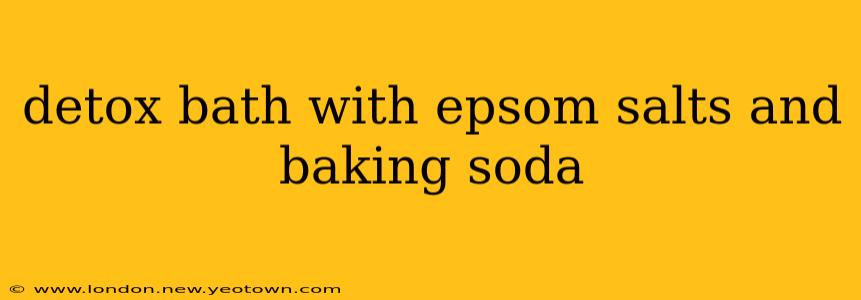Ah, the soothing embrace of a warm bath. But what if that bath could be more than just relaxing? What if it could help your body naturally cleanse and rejuvenate? That's the promise of a detox bath using Epsom salts and baking soda, a simple yet powerful combination that has been used for centuries for its purported health benefits. This isn't a miracle cure, but for many, a detox bath offers a comforting ritual and a chance to unwind and recharge. Let's dive into the details.
What are the benefits of Epsom salt and baking soda baths?
The purported benefits of Epsom salt and baking soda baths often center around detoxification and relaxation. Epsom salt, or magnesium sulfate, is believed to help draw toxins out of the body through the skin. It's also known for its relaxing properties, helping to soothe sore muscles and ease stress. Baking soda, or sodium bicarbonate, is thought to help balance the pH of the skin, potentially reducing inflammation and improving skin conditions. Many find the combination of these two ingredients to be synergistically beneficial.
How to make a detox bath with Epsom salts and baking soda?
Creating your detox bath is simple. Start with a warm, not hot, bath. Hot water can be dehydrating. Add 2 cups of Epsom salts and 1 cup of baking soda to the running water. Stir gently to dissolve the ingredients completely. You can adjust the amounts according to your preference and the size of your tub. Some people also add essential oils for aromatherapy benefits – lavender, chamomile, or eucalyptus are popular choices.
Remember, though, that essential oils should be diluted properly to avoid skin irritation.
What are the potential side effects of Epsom salt and baking soda baths?
While generally safe, Epsom salt and baking soda baths can have some potential side effects. These are usually mild and rare, but it’s always best to be aware. Some individuals may experience skin irritation, particularly if they have sensitive skin or existing skin conditions. If you have any concerns, it's always a good idea to test a small area of skin first. Also, prolonged soaking in hot water can lead to dehydration, so make sure to drink plenty of water before, during, and after your bath.
Can Epsom salt and baking soda baths help with muscle soreness?
Many people find that Epsom salt baths provide significant relief from muscle soreness. The magnesium in Epsom salt is believed to be absorbed through the skin, helping to relax muscles and reduce inflammation. While this isn’t a replacement for medical treatment for muscle injuries, many report it to be a helpful addition to their recovery routine.
Are there any contraindications for using Epsom salts and baking soda baths?
Individuals with certain medical conditions, such as open wounds, severe skin conditions, or kidney problems, should consult their doctor before using Epsom salt and baking soda baths. Pregnant or breastfeeding women should also exercise caution and discuss it with their healthcare provider.
How often should I take an Epsom salt and baking soda bath?
There's no strict guideline on how often you should take a detox bath. Listen to your body. Some people find that once or twice a week is sufficient, while others may enjoy it more frequently. The key is to avoid overdoing it and to stay well-hydrated.
What are some other things I can add to my detox bath?
To enhance the experience further, you can add other ingredients to your detox bath. Essential oils are popular for their aromatherapy benefits, promoting relaxation and mental well-being. A few drops of your favorite oil can transform your bath into a spa-like retreat. Some also add clay to their bath for its purported skin-cleansing properties. Remember to always test any new ingredient on a small patch of skin before adding it to your full bath to check for any potential allergic reactions.
Disclaimer: This information is for educational purposes only and should not be considered medical advice. Always consult with a healthcare professional before starting any new health regimen, especially if you have underlying health conditions.

